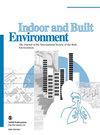Leakage identification and correlation coefficient method for industrial workshop production process combining with computational fluid dynamics
IF 2.9
3区 工程技术
Q2 CONSTRUCTION & BUILDING TECHNOLOGY
引用次数: 0
Abstract
Identifying leakage sources in industrial factory production is crucial to improving air quality, ensuring people’s health and safety and preventing safety accidents. In this study, a method for leakage source identification in industrial factories combining with computational fluid dynamics (CFD) and correlation coefficient was proposed and validated. The study first experimentally validated the numerical methods, which were fundamental to the leakage identification method. Then impacts of leakage sources, sensor errors and number of sensors on the source identification results were evaluated. The results showed that the identification accuracy could be significantly improved by refining the step size of the coefficient a结合计算流体动力学的工业车间生产过程泄漏识别和相关系数方法
识别工业工厂生产中的泄漏源对于改善空气质量、确保人们的健康和安全以及预防安全事故至关重要。本研究提出并验证了一种结合计算流体动力学(CFD)和相关系数的工业工厂泄漏源识别方法。研究首先通过实验验证了数值方法,这是泄漏识别方法的基础。然后评估了泄漏源、传感器误差和传感器数量对泄漏源识别结果的影响。结果表明,通过改进该方法中系数 a r 的步长,可以显著提高识别精度。当泄漏源数量未知时,该方法识别泄漏数量和位置的准确率为 93.5%。用于识别泄漏源的计算时间取决于泄漏源的最大数量。使用四个有误差的传感器足以识别未知泄漏源的数量。同时泄漏源的数量不超过三个。总之,CFD 和相关系数耦合方法可以有效识别泄漏的数量、位置和强度。
本文章由计算机程序翻译,如有差异,请以英文原文为准。
求助全文
约1分钟内获得全文
求助全文
来源期刊

Indoor and Built Environment
环境科学-工程:环境
CiteScore
6.40
自引率
25.00%
发文量
130
审稿时长
2.6 months
期刊介绍:
Indoor and Built Environment publishes reports on any topic pertaining to the quality of the indoor and built environment, and how these might effect the health, performance, efficiency and comfort of persons living or working there. Topics range from urban infrastructure, design of buildings, and materials used to laboratory studies including building airflow simulations and health effects. This journal is a member of the Committee on Publication Ethics (COPE).
 求助内容:
求助内容: 应助结果提醒方式:
应助结果提醒方式:


